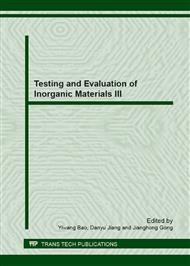p.148
p.152
p.156
p.162
p.167
p.172
p.178
p.183
p.187
Joining of C/SiC Composite and TC4 Alloy Using 70Ag28Cu2Ti Active Brazing Alloy
Abstract:
C/SiC composite and TC4 alloy were successfully brazed using 70Ag28Cu2Ti (wt. %) as filler metal at 820 °C~920 °C for 5 min ~30 min. The effects of brazing parameters on the microstructures, phase composition, shear strength of the brazed joints were investigated by SEM, XRD. The mechanical performances of the brazed joints were measured by a universal mechanical testing machine. The results show that successful joining of C/SiC composite and TC4 alloy owes to interfacial reactions between the brazing alloy and the parent materials, and resultantly produce TiC, Ti5Si3 and Ti-Cu serial compounds at the interfaces; the interfacial structure of the brazed joint is C/SiC composite / TiC / Ti5Si3 /Ag (s.s) +Cu (s.s) / TiCu2 / Ti3Cu4 / TiCu / Ti2Cu / TC4 from C/SiC composite side to TC4 alloy side; the maximum shear strength of the brazed joint is 53.3 MPa at 860°C for 10min.
Info:
Periodical:
Pages:
167-171
Citation:
Online since:
March 2013
Authors:
Keywords:
Price:
Сopyright:
© 2013 Trans Tech Publications Ltd. All Rights Reserved
Share:
Citation:


